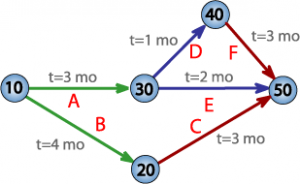Podcast: Play in new window | Download
Subscribe: Apple Podcasts | RSS
 Adam leads the group on a discussion of project management in this episode of The Engineering Commons.
Adam leads the group on a discussion of project management in this episode of The Engineering Commons.
- Please help us improve the podcast by filling out our 2014 Listener Survey!
- Brian feels any technically interesting project is probably of sufficient complexity to require a project manager.
- Since Adam has a certificate in Project Management, he serves as our guide for this conversation.
- Adam refers to a book put out by the Project Management Institute (PMI), titled A Guide to the Project Management Body of Knowledge (PMBOK).
- A project is defined by the PMI as “a temporary group activity designed to produce a unique product, service or result.”
- Jeff wonders whether the company NeXT Computer would therefore have qualified as a project.
- Project that do something for the very first time can become “science projects,” placing unlimited demands on time and money. (With apologies to scientists, who find ways to live within their time and cost constraints ;^)
- Brian notes that engineers, when constructing complicated systems, rely heavily on solutions and technologies provided by vendors.
- Adam and Brian feel that the skills set needed to be a strong technical expert are fairly independent of those needed to be a good project manager.
- Carmen likes “take charge” project managers who quickly get down to business in meetings.
- Jeff mentions President Kennedy’s 1961 proclamation that the United States would send a man to the moon as an example of a leader who didn’t necessarily have strong technical skills, but Brian notes that Wernher von Braun’s engineering expertise was needed to make the project a success.
- A “strong matrix” organization allows project managers to easily pull resources from functional groups, while a “weak matrix” organization gives functional supervisors the authority to deny resources to project managers.
- Project managers have to balance the constraints of time, money, scope, and quality, as represented by the Project Management Triangle.
- A work breakdown structure decomposes a project into smaller tasks that can be carried out to ensure that the project is completed.
- Jeff notes the need to break personal tasks into smaller sub-tasks, such as a “next action,” when working with the Getting Things Done (GTD) method of time management.
- A lot of engineers first get introduced to working with a Gantt chart via the Microsoft Project software program.
- The “critical path” defines the series of events that have to occur on schedule for the project to be completed on time.
- With due credit to Donald Rumsfeld, Adam breaks risk into four categories: known knowns, known unknowns, unknown knowns, and unknown unknowns.
- Risk management methods include acceptance, mitigation, avoidance, and transference.
- Projects typically involve the five stages of initiation, planning, executing, monitoring and controlling, and closing.
- Jeff mentions the “not-invented-here” syndrome, which is an urge to repeatedly “reinvent the wheel.”
- A sturdy wooden gavel is handy for keeping meetings on task, says Carmen.
- According to the PMBOK, the common elements of project management systems are:
- Integration Management
- Scope Management
- Time Management
- Cost Management
- Quality Management
- Human Resource Management
- Communications Management
- Risk Management
- Procurement Management
- Stakeholders Management
Thanks to Wikipedia for the chart titled “Pert_chart_colored.” Podcast theme music provided by Paul Stevenson.